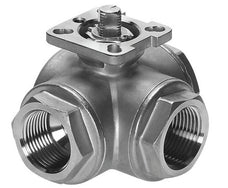Collection:3-Way Stainless Ball Valves (ISO-Top)
Explore Tameson's wide range of manual 3-way stainless steel ball valves with ISO top from various global manufacturers. An ISO-top stainless steel ball valve can be manually operated or by moun... Read more
3-Way Stainless Ball Valves (ISO-Top)

Explore Tameson's wide range of manual 3-way stainless steel ball valves with ISO top from various global manufacturers. An ISO-top stainless steel ball valve can be manually operated or by mounting an electric or pneumatic actuator. 3-way stainless steel ball valves with ISO top have a standardized mounting flange according to ISO 5211 to mount an electrical or pneumatic actuator. Due to this standardization, different brands/types of actuators can be used to drive the valve. There are various flange sizes in the ISO 5211 standard, such as F03, F04, and F05. Ensure that the actuator uses the same flange size and diameter as the drive shaft.
A 3-way ball valve has three ports. They are available in two design types: L-port and T-port. This refers to the bore design in the ball, which is the media flow path. With a 3-way ball valve T-port or L-port, it is possible to mix, distribute, or divert the media flow. A 3-way T-port valve can be used for mixing media from two inlets into a single outlet or for distributing one inlet to two outlets. By changing the position of the handle (90 degree or 180 degree), you can change the circuit function. The 3-way L-port ball valve is designed for flow direction control. The L-port valve has a 90 degree bore inside of the ball, hence the name L-port. An example of an application is to have two inputs from separate tanks and one output, and you want to only use one of the inputs but always the one output. L-port ball valves can have 90 degree or 180 degree handles. Ones with a 180 degree turn allow you to disconnect both inputs from the output, allowing for no flow. Therefore, it is important to know your bore design to ensure your desired media flow, as the ports can be in different positions. The pressure inlet for 3-way ball valves is typically on the center borehole to avoid leakage unless defined otherwise in the product specifications.
The ball valve's stainless steel housing makes them very durable and often a good housing material choice as it generally has a very good overall chemical resistance to almost any medium. Stainless steel is capable of working with aggressive media. These valves are also suitable for water, oil, compressed air, fuels, solvents, and vacuum. The material is highly wear, temperature, and pressure resistant. However, stainless ball valves are unsuitable for hydrochloric acids, chlorides, bromine, and household bleach. Swimming pool water has a low concentration of chlorides, and therefore stainless steel 316 can still be used.



